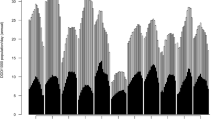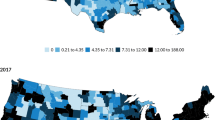Abstract
Five years ago, we highlighted Canada’s emerging problem of prescription opioid (PO)-related harms and emphasized the need for targeted surveillance, research and interventions. Overall levels of PO use in the Canadian population have grown by 70% since then, while at the same time levels of non-medical PO use (NMPOU) in general and in key risk populations have continued to be high; furthermore, PO-related harms — specifically morbidity (e.g., treatment admissions) and mortality (e.g., overdose deaths) — have risen substantively. Unfortunately, major knowledge gaps related to systematic monitoring of PO-related harms continue to exist; for example, no national morbidity or mortality statistics are available. Investigator-driven research has generated important insights into the epidemiology and impacts of PO-related harms: high correlations between population-level PO dispensing and/or PO dosing and harms; high rates of co-occurrence of NMPOU and co-morbidities; and distinct NMPOU-related risk dynamics among street drug users. Select policy measures have been implemented only recently at the federal and provincial levels; these interventions remain to be systematically evaluated, especially given preliminary indications of reductions in PO-related harms (e.g., NMPOU) unfolding prior to the interventions. For these purposes, improvements in surveillance tools and research resources devoted to the extensive public health problem of PO-related harms in Canada continue to be urgently needed.
Résumé
Il y a cinq ans, nous avions souligné l’émergence de méfaits liés aux opioïdes sur ordonnance (OSO) au Canada et le besoin de mener des études et des interventions de surveillance ciblées. Depuis, les niveaux globaux de consommation d’OSO ont augmenté de 70 %, selon des données (provinciales) limitées, tandis que simultanément, les niveaux de consommation d’OSO à des fins non médicales (COSONM) en général et dans les principales populations à risque ont continué d’être élevés, et les méfaits liés aux OSO — spécifiquement la morbidité (les admissions pour traitement) et la mortalité (les décès par surdose) — ont considérablement augmenté. Malheureusement, il existe encore des lacunes majeures dans la surveillance systématique des méfaits liés aux OSO; à titre d’exemple, les statistiques nationales de morbidité ou de mortalité n’existent pas. La recherche menée à l’initiative des chercheurs eux-mêmes a apporté un éclairage utile sur l’épidémiologie et l’impact des méfaits liés aux OSO: corrélations élevées entre la délivrance et/ou le dosage des OSO et leurs méfaits dans la population; taux élevés de concomitance entre la COSONM et les comorbidités; et dynamique du risque distincte liée à la COSONM chez les utilisateurs de drogues de rue. Certaines mesures n’ont été appliquées que récemment aux paliers fédéral et provincial; ces interventions ne sont pas encore systématiquement évaluées mais devraient l’être, surtout que selon les indications préliminaires, la réduction des méfaits liés aux OSO (dont la COSONM) a commencé avant les interventions. Il existe donc toujours un besoin urgent d’améliorer les outils de surveillance et les ressources de recherche consacrés au vaste problème de santé publique des méfaits liés aux OSO au Canada.
Similar content being viewed by others
References
Fischer B, Rehm J, Goldman B, Popova S. Non-medical use of prescription opioids and public health in Canada: An urgent call for research and interventions development. Can J Public Health 2008;99(3):182–84.
International Narcotics Control Board. Narcotic Drugs Technical Report: Estimated World Requirements for 2013 — Statistics for 2011. New York, NY: United Nations, 2013.
Fischer B, Ialomiteanu A, Boak A, Adlaf E, Rehm J, Mann R. Prevalence and key covariates of non-medical prescription opioid use among the general secondary student and adult populations in Ontario, Canada. Drug Alcohol Rev 2013;32(3):276–87.
Brands B, Paglia-Boak A, Sproule BA, Leslie K, Adlaf EM. Nonmedical use of opioid analgesics among Ontario students. Can Fam Physician 2010;56(3):256–62.
Public Health Agency of Canada. I-Track: Enhanced Surveillance of Risk Behaviours Among People Who Inject Drugs — Phase I Report. Ottawa, ON: Surveillance and Risk Assessment Division, Centre for Infectious Disease Prevention and Control, Public Health Agency of Canada, 2006.
Fischer B, Argento E. Prescription opioid related misuse, harms, diversion and interventions in Canada: A review. Pain Physician 2012;153 (Suppl):ES191–ES203.
Drug and Alcohol Treatment Information System. Substance Abuse Statistical Tables: Fiscal Year 2007/2008 to Fiscal Year 2011/2012. Toronto, ON: Centre for Addiction & Mental Health, 2012.
Office of the Chief Coroner of Ontario. Office of the Chief Coroner Report for 2009–2011. Toronto: Ministry of Community Safety and Correctional Services, 2012.
Madadi P, Hildebrandt D, Lauwers AE, Koren G. Characteristics of opioid-users whose death was related to opioid-toxicity: A population-based study in Ontario, Canada. PLoS One 2013;(84):e60600.
Shield KD, Jones W, Rehm J, Fischer B. Use and nonmedical use of prescription opioid analgesics in the general population of Canada and correlations with dispensing levels in 2009. Pain Res Manag 2013;18(2):69–74.
Fischer B, Ialomiteanu A, Kurdyak P, Mann RE, Rehm J. Reductions in nonmedical prescription opioid use among adults in Ontario, Canada: Are recent policy interventions working? Subst Abuse Treat Prev Policy 2013;8(1):4.
Substance Abuse and Mental Health Services Administration. Results from the 2010 National Survey on Drug Use and Health: Summary of National Findings. Rockville, MD: Substance Abuse and Mental Health Services Administration, 2011.
Health Canada. Canadian Alcohol and Drug Use Monitoring Survey (CADUMS): Summary of Results for 2011, 2012. Available at: http://www.hc-sc.gc.ca/hc-ps/drugs-drogues/stat/_2011/summary-sommaire-eng.php (Accessed November 23, 2012).
Centers for Disease Control and Prevention. Policy Impact: Prescription Painkiller Overdoses, 2013. Available at: http://www.cdc.gov/homeandrecreationalsafety/rxbrief/ (Accessed July 5, 2013).
Health Canada. HIV/AIDS: Reports and Publications, 2013. Available at: http://www.phac-aspc.gc.ca/aids-sida/publication/ (Accessed July 5, 2013).
Fischer B, Bibby M, Bouchard M. The global diversion of pharmaceutical drugs non-medical use and diversion of psychotropic prescription drugs in North America: A review of sourcing routes and control measures. Addiction 2010;105(12):2062–70.
Potter JS, Marino EN, Hillhouse MP, Nielsen S, Wiest K, Canamar CP, et al. Buprenorphine/naloxone and methadone maintenance treatment outcomes for opioid analgesic, heroin, and combined users: Findings from Starting Treatment With Agonist Replacement Therapies (START). J Stud Alcohol Drugs 2013;74(4):605–13.
Weiss RD, Potter JS, Fiellin DA, Byrne M, Connery HS, Dickinson W, et al. Adjunctive counseling during brief and extended buprenorphine-naloxone treatment for prescription opioid dependence: A 2-phase randomized controlled trial. Arch Gen Psychiatry 2011;68(12):1238–46.
Moore BA, Fiellin DA, Barry DT, Sullivan LE, Chawarski MC, O’Connor PG, et al. Primary care office-based buprenorphine treatment: Comparison of heroin and prescription opioid dependent patients. J Gen Intern Med 2007;22(4):527–30.
National Treatment Strategy Working Group. A Systems Approach to Substance Use in Canada: Recommendations for a National Treatment Strategy. Ottawa: National Framework for Action to Reduce the Harms Associated with Alcohol and Other Drugs and Substances in Canada, 2008.
Pirie T, Jesseman R, National Treatment Indicators Working Group. National Treatment Indicators Report: 2010–2011 Data. Ottawa: Canadian Centre on Substance Abuse, 2013.
Fischer B, Jones W, Krahn M, Rehm J. Differences and over-time changes in levels of prescription opioid analgesic dispensing from retail pharmacies in Canada, 2005–2010. Pharmacoepidemiol Drug Saf 2011;20(12):1269–77.
Gomes T, Juurlink DN, Moineddin R, Gozdyra P, Dhalla I, Paterson M, et al. Geographical variation in opioid prescribing and opioid-related mortality in Ontario. Healthc Q 2011;14(1):22–24.
Fischer B, Jones W, Rehm J. High correlations between levels of consumption and mortality related to strong prescription opioid analgesics in British Columbia and Ontario, 2005–2009. Pharmacoepidemiol Drug Saf 2013;22(4):438–42.
Dhalla IA, Mamdani MM, Sivilotti ML, Kopp A, Qureshi O, Juurlink DN. Prescribing of opioid analgesics and related mortality before and after the introduction of long-acting oxycodone. CMAJ 2009;181(12):891–96.
Dhalla IA, Mamdani MM, Gomes T, Juurlink DN. Clustering of opioid prescribing and opioid-related mortality among family physicians in Ontario. Can Fam Physician 2011;57(3):e92–e96.
Amari E, Rehm J, Goldner E, Fischer B. Nonmedical prescription opioid use and mental health and pain comorbidities: A narrative review. Can J Psychiatry 2011;56(8):495–502.
Fischer B, Nakamura N, Urbanoski K, Rush B, Rehm J. Correlations between population levels of prescription opioid use and prescription opioid-related substance use treatment admissions in the USA and Canada since 2001. Public Health 2012;126(9):749–51.
Lusted A, Roerecke M, Goldner E, Rehm F, Fischer B. Prevalence of pain among non-medical prescription opioid users in substance use treatment populations: Systematic review and meta-analysis. Pain Physician 2013;16(6):E671–E684.
Roy É, Arruda N, Bourgois P. The growing popularity of prescription opioid injection in downtown Montreal: New challenges for harm reduction. Subst Use Misuse 2011;46(9):1142–50.
Bruneau J, Roy E, Arruda N, Zang G, Jutras-Aswad D. The rising prevalence of prescription opioid injection and its association with hepatitis C incidence among street-drug users. Addiction 2012;107(7):1318–27.
Expert Working Group on Narcotic Addiction. The Way Forward: Stewardship for Prescription Narcotics in Ontario. Toronto: Ontario Ministry of Health and Long-Term Care, 2012.
Health Canada. Statement on the Authorization of Generic OxyContin, 2012. Available at: http://www.hc-sc.gc.ca/ahc-asc/media/ftr-ati/_2012/2012_1 76-eng.php (Accessed July 5, 2013).
Canadian Centre on Substance Abuse. Release of First Do No Harm: Responding to Canada’s Prescription Drug Crisis Collective Challenge Requires Collective Action, 2013. Available at: http://www.ccsa.ca/2013%20CCSA%20Documents/CCSA-Prescription-Drug-Strategy-news-release-2013-en.pdf (Accessed July 5, 2013).
Health Canada. Federal Tobacco Control Strategy (FTCS), 2007. Available at: http://www.hc-sc.gc.ca/hc-ps/tobac-tabac/res/news-nouvelles/ftcs-sflt-eng.php (Accessed July 5, 2013).
Department of Justice Canada. National Anti-Drug Strategy for Safer and Healthier Communities, 2008. Available at: http://www.nationalantidrugstrategy.gc.ca/ (Accessed July 5, 2013).
Rehm J, Gnam W, Popova S, Baliunas D, Brochu S, Fischer B, et al. The cost of alcohol, illegal drugs, and tobacco in Canada in 2002. J Stud Alcohol Drugs 2007;68(6):886–95.
Author information
Authors and Affiliations
Corresponding author
Additional information
Acknowledgements: Benedikt Fischer and Jürgen Rehm acknowledge Canadian Institutes of Health Research (CIHR) grants SAF-94814 and GIR-109852. Benedikt Fischer also acknowledges salary and research support from a CIHR/Public Health Agency of Canada Applied Public Health Research Chair.
Conflict of Interest: None to declare.
Rights and permissions
About this article
Cite this article
Fischer, B., Gooch, J., Goldman, B. et al. Non-medical prescription opioid use, prescription opioid-related harms and public health in Canada: An update 5 years later. Can J Public Health 105, e146–e149 (2014). https://doi.org/10.17269/cjph.105.4143
Received:
Accepted:
Published:
Issue Date:
DOI: https://doi.org/10.17269/cjph.105.4143




